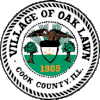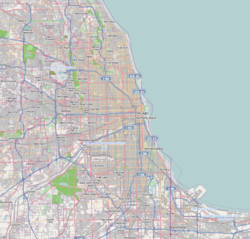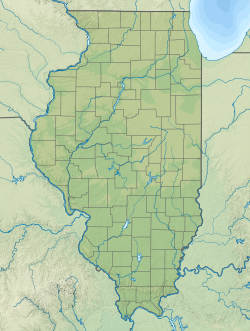Oak Lawnis avillageinCook County, Illinois,United States. The population was 58,362 at the2020 census.[2]Oak Lawn is a suburb ofChicago,located southwest of the city. It shares borders with the city in two areas but is surrounded mostly by other suburbs.
Oak Lawn, Illinois | |
|---|---|
 | |
 Location of Oak Lawn in Cook County, Illinois | |
| Coordinates:41°42′54″N87°45′12″W/ 41.71500°N 87.75333°W | |
| Country | |
| State | |
| County | Cook |
| Township | Worth |
| Incorporated | 1909 |
| Government | |
| • Type | Council–manager |
| •President | Terry Vorderer |
| Area | |
| • Total | 8.57 sq mi (22.20 km2) |
| • Land | 8.57 sq mi (22.20 km2) |
| • Water | 0.00 sq mi (0.00 km2) 0% |
| Population (2020) | |
| • Total | 58,362 |
| • Density | 6,809.24/sq mi (2,629.13/km2) |
| Standard of living (2009-11) | |
| •Per capita income | $27,851 |
| •Median home value | $213,700 |
| ZIP code(s) | 60453, 60454, 60455, 60456, 60457, 60458, 60459 |
| Area code(s) | 708 |
| Geocode | 54820 |
| FIPS code | 17-54820 |
| Website | www |
History
editFounding
editIn August 1835, James B. Campbell purchased the land stretching betweenCicero Avenueand Central Avenue from95th Streetto 103rd Street. It is unclear what Campbell's intentions with the area were, but by 1840, he had lost a court battle with the Illinois State Bank and his land was sold in a public auction. John Simpson, a prominent figure in early Oak Lawn history, bought the northern half of the property in 1842. By 1859, the recently incorporated government ofWorth Townshippaid for the construction of Black Oak Grove Road, an early name for 95th Street. Black Oak Grove is also the earliest known name of the area that would become Oak Lawn. It was later shortened to Black Oak or Black Oaks, but in 1882, thepost office,train depot and surrounding community became known simply as Oak Lawn. Before this however, the area now known as Oak Lawn was, briefly during the early 1800s, called Agnes. It was also on some occasion referred to as Oak Park. Over the next two decades, the area grew in population as more homes were built and local business sprang into being.[3]As the area continued to grow, many residents visited Englewood by train to shop. Oak Lawn residents also made income during early days by selling their farm and dairy products to various markets in Chicago.
Incorporation
editIn 1909, Oak Lawn wasincorporated as a village.The following years, there were major improvements to local infrastructure and government services, such as the introduction of thepolice magistrateandvillage marshal,along with the building of avillage halland jailhouse.[4]Electric lights were brought to95th Streetin 1911, thevolunteer fire departmentbegan in 1923, Oak Lawn's first bank opened in 1925, and theCommunity High School District 218was formed. The population had grown to 2,045 by 1930, and civic improvements were steadily made over the next decade.[5]In 1934, a collection of one hundred books was the beginning of the Oak Lawn Public Library. By 1935, PresidentFranklin D. Rooseveltcreated theWorks Progress Administrationas part of theNew Deal,which supported a variety of public works, including libraries. With the help of a WPA grant, the new library opened its doors in 1936.[6]
Post 1945
editAfterWorld War II,with veterans returning home and taking advantage of theG.I. Bill,Oak Lawn experienced a major population boom. Beginning in 1949, Oak Lawn Round-Up Days became an annual event and helped to promote the village. It started with 25,000 people, and the Western-themed celebration brought in over 100,000 attendees in 1952. In this year,Jack Brickhousewas master of ceremonies, and the parade was televised onWGN-TV.By 1957, Round-Up Days had become too large, and the next year a final scaled-down version was held.[7]
In the 1950s, a village managerial government began, and a new library and fire station were constructed. By 1960, there were nearly 20,000 residents in Oak Lawn.
On April 21, 1967, a tornado touched down in Oak Lawn that is recorded as one of the worst to strike an urban area. Roughly 900 buildings were damaged or destroyed, and over 30 people were killed.
The town was rebuilt in the coming years, and witnessed further population growth, peaking at 63,500 between 1973 and 1976.[3]However, there was a decrease in residents in the 1980s, and an aging population led to the closure of several schools during this time. In response, the village began a process of redevelopment to counteract the decrease. This redevelopment has focused primarily on businesses and structures in the core area of Oak Lawn, around95th StreetbetweenCicero Avenueand Central Avenue.
1967 tornado
editOn April 21, 1967, an F4 tornado touched down at 105th Street and Kean Avenue inPalos Hills,5 miles (8 km) west of Oak Lawn. There were no deaths in Palos Hills, although a number of homes were destroyed and two transmission towers collapsed. After rising from the ground, the tornado touched down again at the Starlite Drive-In Theater at 6400 West 95th Street. With winds estimated to be over 200 miles per hour (320 km/h), the tornado tore through Oak Lawn, tossing cars and buses in the air. After cutting Oak Lawn Community High School in half, it caused damage to St. Gerald's and continued to 91st Street and Cicero Avenue, heavily damaging the Airway Trailer Park and the Oak Lawn Roller Rink before rising from ground level. It touched down again in nearbyHometown,Evergreen Park,and Chicago before dissipating overLake Michigan.In just 16 minutes, the storm left a 16-mile (26 km) path of destruction and over 30 people dead.[8]
Downtown redevelopment
editStarting in 2002, downtown Oak Lawn (95th Street between Tulley Avenue and 55th Court) became the target of a massive redevelopment program; properties on the north and south sides of 95th Street were demolished. Eventually, several square blocks were leveled, making room for several multistory, high-end condominium complexes with retail space on the main floors. Part of the project was the expansion of theMetracommuter train stationthat houses a retail/office center and a new children's museum.[9]This complex also includes a multistory parking garage. Downtown Oak Lawn as seen today bears little resemblance to the downtown from 2002. It now features modern high-rise buildings, new shopping areas, a large contemporary Metra train station,[10]and several new retail and service facilities.
Geography
editAccording to the 2010 census, Oak Lawn has a total area of 8.59 square miles (22.25 km2), all land.[11]
Demographics
edit| Census | Pop. | Note | %± |
|---|---|---|---|
| 1910 | 287 | — | |
| 1920 | 489 | 70.4% | |
| 1930 | 2,045 | 318.2% | |
| 1940 | 3,483 | 70.3% | |
| 1950 | 8,751 | 151.2% | |
| 1960 | 27,471 | 213.9% | |
| 1970 | 60,305 | 119.5% | |
| 1980 | 60,590 | 0.5% | |
| 1990 | 56,182 | −7.3% | |
| 2000 | 55,245 | −1.7% | |
| 2010 | 56,690 | 2.6% | |
| 2020 | 58,362 | 2.9% | |
| U.S. Decennial Census[12] 2010[13]2020[14] | |||
As of the2020 census[15]there were 58,362 people, 21,154 households, and 13,544 families residing in the village. The population density was 6,809.24 inhabitants per square mile (2,629.06/km2). There were 23,362 housing units at an average density of 2,725.70 per square mile (1,052.40/km2). The racial makeup of the village was 68.31%White,7.65%African American,0.87%Native American,2.83%Asian,0.02%Pacific Islander,9.43% fromother races,and 10.89% from two or more races.HispanicorLatinoof any race were 22.56% of the population.
There were 21,154 households, out of which 28.5% had children under the age of 18 living with them, 46.89% were married couples living together, 11.64% had a female householder with no husband present, and 35.97% were non-families. 32.16% of all households were made up of individuals, and 15.73% had someone living alone who was 65 years of age or older. The average household size was 3.33 and the average family size was 2.60.
The village's age distribution consisted of 21.7% under the age of 18, 7.0% from 18 to 24, 25.3% from 25 to 44, 27.6% from 45 to 64, and 18.5% who were 65 years of age or older. The median age was 41.0 years. For every 100 females, there were 96.5 males. For every 100 females age 18 and over, there were 91.8 males.
The median income for a household in the village was $69,352, and the median income for a family was $90,690. Males had a median income of $54,168 versus $38,363 for females. Theper capita incomefor the village was $33,998. About 7.5% of families and 10.1% of the population were below thepoverty line,including 13.2% of those under age 18 and 9.6% of those age 65 or over.
| Race / Ethnicity(NH = Non-Hispanic) | Pop 2010[13] | Pop 2020[14] | % 2010 | % 2020 |
|---|---|---|---|---|
| Whitealone (NH) | 43,680 | 37,499 | 77.05% | 64.25% |
| Black or African Americanalone (NH) | 2,893 | 4,335 | 5.10% | 7.43% |
| Native AmericanorAlaska Nativealone (NH) | 54 | 84 | 0.10% | 0.14% |
| Asianalone (NH) | 1,207 | 1,630 | 2.13% | 2.79% |
| Pacific Islanderalone (NH) | 14 | 6 | 0.02% | 0.01% |
| Some Other Racealone (NH) | 76 | 204 | 0.13% | 0.35% |
| Mixed Race or Multi-Racial(NH) | 658 | 1,437 | 1.16% | 2.46% |
| Hispanic or Latino(any race) | 8,108 | 13,167 | 14.30% | 22.56% |
| Total | 56,690 | 58,362 | 100.00% | 100.00% |
Parks and recreation
editOak Lawn maintains an expansive park system.[16]From small corner play lots to the 38-acre (150,000 m2) Centennial Park, there are over 300 acres (1.2 km2) of parks, recreational facilities and open land. These include playgrounds, walking paths, baseball fields, basketball, volleyball and tennis courts, plus outdoor swimming pools, an indoor ice arena, two fitness centers, and an 18-hole golf course. Each area in Oak Lawn has its own recreational area, totaling 22 parks.
Education
editThis sectionneeds expansion.You can help byadding to it.(May 2020) |
This articleneeds additional citations forverification.(May 2020) |
Oak Lawn has public education schooling children from K–5 in its many elementary schools, including Kolb, Lieb, Harnew, Columbus Manor, Covington, Hannum, Hometown, Kolmar, and Sward. Oak Lawn has two public middle schools: Simmons Middle School, and Oak Lawn-Hometown Middle School.
There are two public high schools,Oak Lawn Community High SchoolandHarold L. Richards High School.
TheRoman Catholic Archdiocese of Chicagooperates Catholic schools. Catholic grammar schools include St. Germaine, St. Catherine, St. Linus, and St. Gerald. St. Louis de Montfort School closed in 2017 with 133 students that year.[17]
Infrastructure
editOak Lawn has acommuter railroad stationonMetra'sSouthWest Serviceline with service to downtown Chicago andManhattan, Illinois.It has connections to twoPaceroutes, while other routes run along the village borders.
Stop sign program
editIn mid-2007, Oak Lawn began hanging additional messages to village stop signs in an attempt to have drivers obey the signs. The signs were the idea of the village President, Dave Heilmann, and local residents were encouraged to submit their own ideas. Found throughout the village, the signs garnered attention with the press and were not well received by residents, nor did they noticeably impact public safety.[18]While considered humorous by some, many others considered it a publicity stunt at tax payer's expense.[19]
TheFederal Highway Administration(FHWA) andIDOTvoiced their concerns about the use of these nonconforming stop signs and the village removed them in April 2008.[20]Initially, the Village President refused to remove the signs until IDOT threatened to withhold millions of dollars in funding for infrastructure.
Notable people
edit- Diandra Asbaty(born 1980), professional bowler; Team USA member and spokesperson forUSBC
- Brian Bogusevic(born 1984), former outfielder forChicago Cubs[21]
- Tim Byrdak(born 1973), Major League Baseball pitcher 1998 to 2013; born in Oak Lawn
- Kevin Cronin(born 1951), lead vocalist for rock bandREO Speedwagon[22]
- David Diehl(born 1980), football player, two-time Super Bowl champion forNew York Giants[23]
- Mark Donahue,football player, lineman forCincinnati Bengals,two-time Consensus All-American atUniversity of Michigan
- Dan Donegan,guitarist for rock bandDisturbed
- John Joseph Duda,actor; born in Oak Lawn
- Michael Flatley(born 1958), Irish step dancer; attended St. Linus andBrother Rice High School[24]
- Jack Gwynne,illusionist and actor, died in Oak Lawn (1969)
- Richard Hanania,right-wing author and academic
- David A. Johnston,volcanologist, killed during 1980Mount St. Helenseruption
- Benn Jordan,recording artist known asThe Flashbulb;attended Oak Lawn Community High School
- C.J. Kupec,basketball player, Oak Lawn High School star, played forMichiganand NBA 'sLos Angeles Lakers
- Sean Lewis,college football coach, attended Harold L. Richards High School[25]
- Rob Mackowiak,player for severalMajor League Baseballteams[26]
- Bobby Madritsch,former pitcher forSeattle Mariners
- Rory Markham,UFC and IFL mixed martial arts fighter
- Mike Mollo,heavyweight boxer
- Bryan Rekar,former pitcher forColorado Rockies,Tampa Bay Devil Rays,andKansas City Royals;born in Oak Lawn
- Michael A. Ruddy,Illinois state representative and businessman, lived in Oak Lawn[27]
- Marc Rzepczynski,pitcher forSeattle Mariners;born in Oak Lawn
- Dwyane Wade,former NBA player and three-time NBA champion withMiami Heat,attended Richards High School in Oak Lawn
- Harry Yourell,Illinois state representative and businessman
- Kanye West,musician, rapper, singer, songwriter, record producer, and fashion designer[28][29]
- Juice WRLD,rapper, died in Oak Lawn (2019)
See also
editReferences
edit- ^"2020 U.S. Gazetteer Files".United States Census Bureau.RetrievedMarch 15,2022.
- ^"Oak Lawn village, Illinois".United States Census Bureau.RetrievedMarch 13,2022.
- ^ab[1]ArchivedSeptember 28, 2011, at theWayback Machine,Oak Lawn: A Century of Growth. The Centennial Commission. 1982
- ^[2]ArchivedSeptember 28, 2011, at theWayback Machine,Village Adopts New Name, Government. Black Oak and After. Gordon Welles and Gerald Anderson.
- ^[3]ArchivedSeptember 28, 2011, at theWayback Machine,Oak Lawn: A Century of Growth. The Centennial Commission. 1982.
- ^[4]ArchivedSeptember 28, 2011, at theWayback Machine,The Oak Lawn Public Library. Black Oak and After. Verlyn Biere, edited by Grant Subs.
- ^[5]ArchivedSeptember 28, 2011, at theWayback Machine,Oak Lawn Round-Up 1949–1958. Black Oak and After. Gordon Welles.
- ^[6]ArchivedSeptember 28, 2011, at theWayback Machine,The 1967 Oak Lawn Tornado. Black Oak and After. Barbara Wolfe.
- ^"Children's Museum in Oak Lawn".Children's Museum in Oak Lawn.
- ^"Metra train station".Archived fromthe originalon January 11, 2014.RetrievedJanuary 11,2014.
- ^"G001 – Geographic Identifiers – 2010 Census Summary File 1".United States Census Bureau.Archived fromthe originalon February 13, 2020.RetrievedDecember 25,2015.
- ^"Decennial Census of Population and Housing by Decades".US Census Bureau.
- ^ab"P2 Hispanic or Latino, and Not Hispanic or Latino by Race – 2010: DEC Redistricting Data (PL 94-171) - Oak Lawn village, Illinois".United States Census Bureau.
- ^ab"P2 Hispanic or Latino, and Not Hispanic or Latino by Race – 2020: DEC Redistricting Data (PL 94-171) - Oak Lawn village, Illinois".United States Census Bureau.
- ^"Explore Census Data".data.census.gov.RetrievedJune 28,2022.
- ^"Oak Lawn Park District – Oak Lawn, IL".olparks.
- ^Kennedy, Mike (January 12, 2017)."2 Catholic schools in Chicago's south suburbs will close".American School & University.RetrievedMay 7,2020.
- ^Stop me if you've heard this one: Traffic signs offer humor with a messageChicago Sun-Times, September 29, 2007
- ^"Chicago Tribune: Chicago news, sports, weather, entertainment".Chicago Tribune.May 2008.
- ^"Chicago Local News, Weather, Traffic, US & World and Breaking News".NBC Chicago.
- ^Staff."Former Phillies outfielder Brian Bogusevic signs with NPB's Orix Buffaloes",Philadelphia, December 9, 2015. Accessed June 15, 2016. "Bogusevic, 31, began last season with the Triple-A Lehigh Valley IronPigs, despite slugging.611 in 36 spring training at-bats.The Oak Lawn, Illinois native was not recalled until Sept. 4."
- ^Williams, Kevin."REO Speedwagon embraces its past, future",Chicago Tribune,May 14, 2010. Accessed June 15, 2016. "Cronin and his bandmates are homeboys even though they all live in Los Angeles now. He grew up in Oak Lawn as the weird kid with the long hair and funny clothes who played guitar all the time, went to high school at Brother Rice and to college at Loyola University in Rogers Park."
- ^Haugh, David."Father's example lives on in Diehl; Giants offensive tackle's strong work ethic instilled growing up on South Side",Chicago Tribune,February 3, 2008. Accessed June 15, 2016. "That all changed when the Diehls moved out of the neighborhood to Oak Lawn before David started 8th grade."
- ^Staff."Flatley's Generosity Benefits Special School",Sun-Sentinel,May 1, 2000. Accessed June 15, 2016. "Flatley, creator and star of Lord of the Dance, donated the money Friday to Elim Christian School, which serves students with developmental disabilities, including Flatley's niece, 14. Flatley grew up in nearby Oak Lawn, Ill."
- ^Paha, Jason (August 17, 2003)."Let the games begin".Southtown Star.p. C-1.RetrievedNovember 28,2023– viaNewspapers.
- ^"Player FIle".MLB.RetrievedDecember 8,2009.
- ^'Michael Ruddy; Served 19 Years In State House,'The Chicago Tribune,June 3, 1987
- ^Davis, Kimberly (June 2004)."The Many Faces of Kanye West".Ebony.p. 92.RetrievedJuly 19,2007.
- ^Tyrangiel, Josh (August 21, 2005)."Why You Can't Ignore Kanye".Time.Archived fromthe originalon April 1, 2007.RetrievedJune 7,2007.




